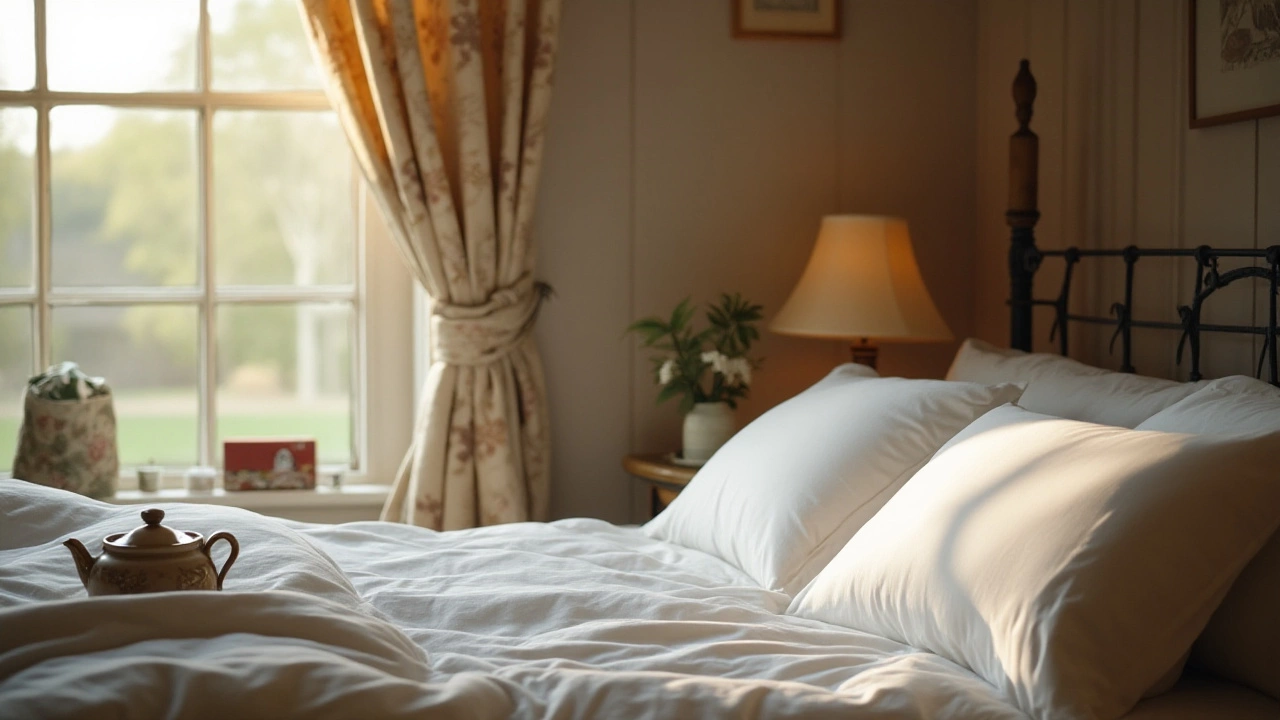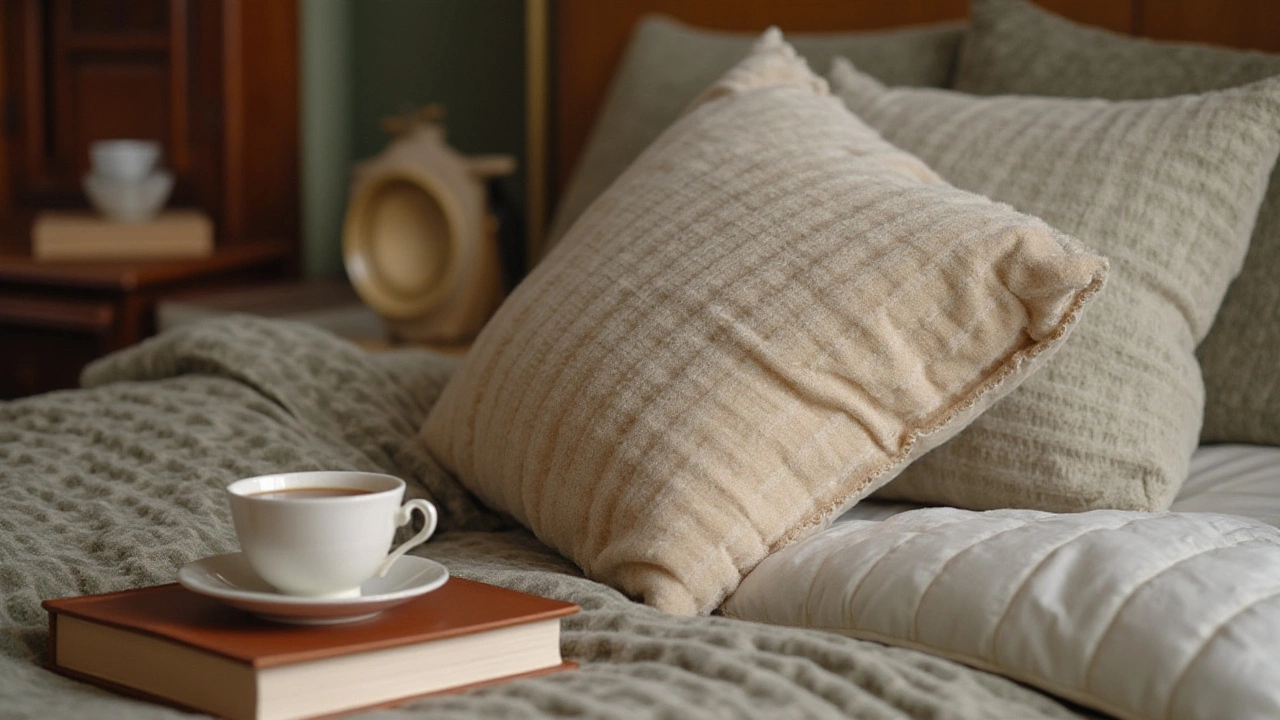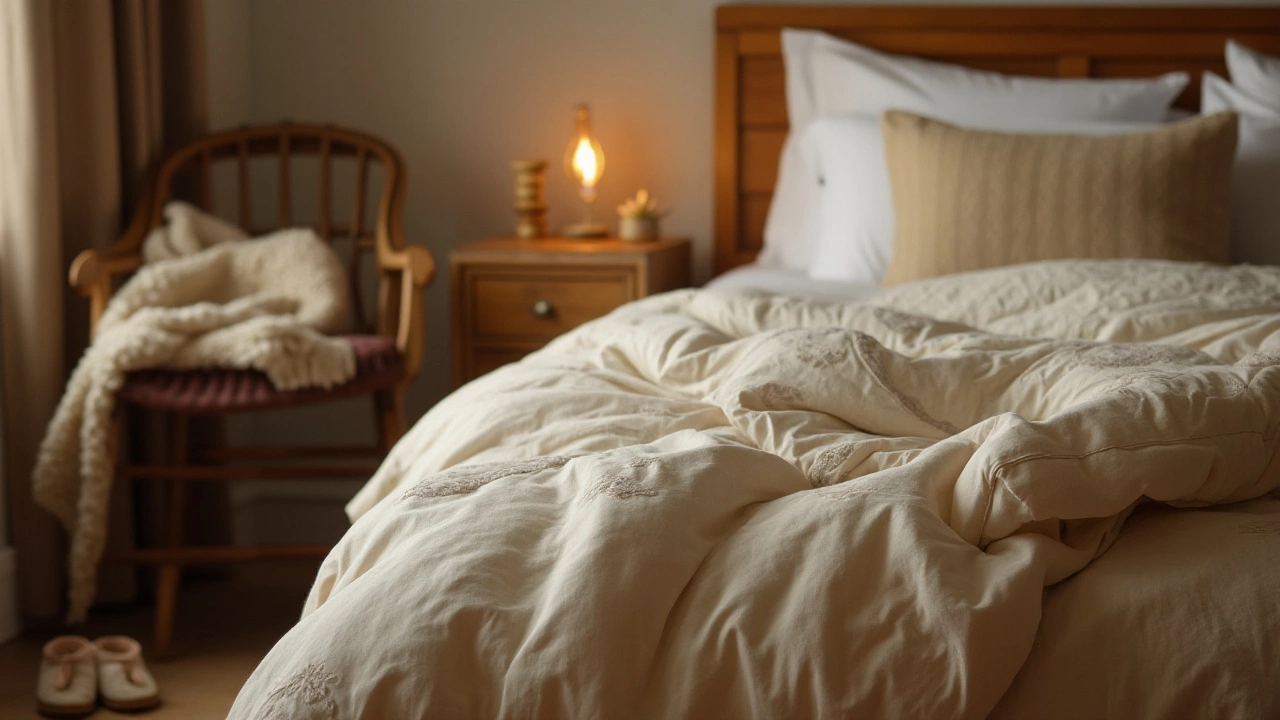Essential Guide to Basic Bedding: A Restful Night's Perfect Foundation
 Jan, 16 2025
Jan, 16 2025
When it comes to a restful night's sleep, the basics of bedding play a crucial role. While it might seem simple, choosing the right bedding goes beyond picking a favorite color or style. It's about creating a comfortable and inviting environment that meets your unique needs. Delving into the details of materials, we can uncover how to make informed decisions that will enhance sleep quality.
From the fabric of your sheets to the fill of your comforter, each element of a bedding ensemble serves its purpose. Understanding these components can transform your nightly retreat into a haven of comfort. Discovering the right blend of materials and proper care techniques will not only enhance longevity but also contribute to better sleep hygiene. This article sheds light on the essentials you need to know to achieve a perfect foundation for restful slumber.
- Understanding Basic Bedding
- Choosing the Right Materials
- Caring for Your Bedding
- Enhancing Sleep Comfort
Understanding Basic Bedding
Diving into the realm of basic bedding is like opening the door to a world of comfort and sleep bliss. It's about creating a cozy nest that not only reflects your style but also caters to the fundamental need for a good night's rest. The concept of basic bedding encompasses the essential components which include sheets, pillows, pillowcases, and comforters. Each piece serves its own distinct purpose, but together, they create the foundation for sleep that helps us recharge and take on our days. The journey into basic bedding begins with understanding what each component offers and how it contributes to the overall sleep experience.
Sheets are where we start. The essential underlayer that wraps around your mattress and provides a smooth surface for sleeping is incredibly important. Bedsheets, available in an array of fabrics, such as cotton, silk, linen, and microfiber, set the initial tone for your night's rest. Cotton, particularly Egyptian or Pima, is a popular choice due to its breathability and softness. People often debate thread count when selecting sheets, with some suggesting that a higher count implies luxury and durability. However, it's crucial to note that fabric type and weave can be just as significant. Silk sheets, with their natural temperature-regulating properties and indulgent feel, introduce a sense of luxury, yet require delicate care.
Next, we consider the pillow, a critical element in the basic bedding lineup. According to the Sleep Foundation, selecting the right pillow can greatly reduce neck and back pain, leading to a better quality of sleep. It's not just about choosing soft or firm; the fill material is of equal importance. Options abound from natural fills like feather and down, which provide a supple cushioned support, to synthetic alternatives such as memory foam, which conform to your head and neck for optimal alignment. The latter is especially favored by those who suffer from chronic pain as it helps maintain posture.
"A good pillow supports not only your head but your upper body, helping to distribute the weight evenly," says Dr. Susan Gordon, a noted sleep expert.
Comforters and duvets complete the ensemble, adding warmth and texture. They also embody personal style more overtly, often acting as the centerpiece of your bedroom decor. The choice of filling—such as down, wool, or synthetic down alternatives—affects both warmth and weight, influencing sleep comfort throughout the night. Studies have shown that sleeping with a heavy comforter can reduce anxiety, as the weight provides a soothing effect similar to a gentle hug. Consider factors like seasons and temperature; owning more than one type is often practical for year-round comfort.
To assemble the ideal basic bedding, it's helpful to think of these elements as a toolkit for achieving restful sleep. With careful selection and an understanding of the role each plays, your bedding can be both a sleep sanctuary and a statement of personal style. The choices are broad, but every thoughtful decision contributes to crafting a space that's as comforting as it is functional. By mastering the basics of bedding, you lay down not just for sleep, but for a better day ahead.

Choosing the Right Materials
When we embark on the journey to select the perfect bedding, understanding the variety of materials available is key. The world of bedding materials is diverse, offering everything from natural fibers like cotton and linen to modern synthetics such as microfiber and polyester. Each of these materials brings its unique set of properties, impacting factors like comfort, breathability, and durability. Cotton is often hailed as the king of bedding materials because of its softness, breathability, and moisture-wicking qualities. There's Egyptian cotton, with its luxurious finish, renowned for its durability, and then there's organic cotton, which offers a more eco-friendly choice.
On the other hand, linen provides a distinct charm with its textured feel and exceptional breathability, making it an excellent choice for warmer climates. Linen, although initially rough to the touch, softens beautifully over time, revealing its true essence. Synthetic fibers, like microfiber, offer a practical solution due to their affordability and ease of care. Often featuring a smooth, silky texture, microfiber sheets are lightweight yet warm, ideal for those looking for simple maintenance and convenience.
As we delve deeper, consider the thread count, which often comes up in bedding discussions. While many associate a higher thread count with better quality, this isn't always the case. A balance between thread count and material quality is vital, as sometimes a lower thread count in a superior material can surpass a high thread count in an average one. In this quest for the perfect bedding, acknowledging the value of seasonal considerations is crucial. Warmer months may call for lightweight materials like cotton or linen, while winter may beckon the coziness of flannel or heavier synthetics.
The Sleep Foundation notes, 'The best bedding choices are those that align with the climate while complementing personal warmth needs.'
The Importance of Knowing Your Needs
When selecting bedding, personal preference often plays a significant role alongside material properties. For individuals with allergies, hypoallergenic fabrics such as bamboo or specific microfibers become important. Bamboo fiber, a relatively new but popular option, is not only hypoallergenic but also environmentally friendly due to its sustainable sourcing. It's naturally antibacterial and moisture-wicking, providing an extra level of comfort and hygiene.Deep diving into bedding materials also calls for an understanding of environmental impacts and sustainability. As consumers grow more conscious, choices like organic cotton and bamboo gain popularity for their minimal ecological footprint. Prioritizing eco-friendly options can align perfectly with the modern emphasis on sustainability, supporting long-term environmental health. All these aspects, from personal needs to environmental considerations, weave together to inform the best choice of bedding essentials for a perfect night’s rest. Considering all these factors ensures not just a good night's sleep, but also peace of mind.

Caring for Your Bedding
Caring for your bedding is crucial to maintaining its look and comfort over time. It starts with knowing how to wash each piece correctly, as improper handling can wear out the fibers or cause colors to fade. Most sheets and pillowcases will require washing once a week to prevent buildup of dirt, sweat, and oils. Use a gentle cycle with mild detergent, and consider washing in cold water to preserve colors and fabric integrity. It's important to resist the urge to overload your washing machine; ample space allows for effective cleaning and prevents strain on fabrics. Drying your bedding in direct sunlight can naturally sanitize it, but be cautious with dark colors as extended exposure to sunlight can cause fading.
When it comes to comforters and pillows, washing them can be a bit more complex. Typically, these larger items only need cleaning every few months. Always check care labels for specific instructions. If your washing machine can't accommodate these sizable items, which is often the case, consider visiting a laundromat with larger capacity machines. Use a mild detergent and select a gentle cycle again to protect the fillings. It's highly recommended to use tennis balls or dryer balls in the machine, which help keep the filling evenly distributed as it dries. This can prevent clumping and ensure your bedding retains its fluffiness.
An often overlooked aspect of bedding care is choosing the right storage method during the off-season. For instance, if you have luxury wool blankets or feather pillows that you only use in winter, storing them properly when not in use is key to preserving their quality. Invest in breathable cotton bags or natural fabric storage containers to prevent mildew and musty odors. Storage should be in a cool, dry place to ward off potential damage from moisture. Using cedar blocks or lavender sachets can also deter pests, ensuring your bedding remains fresh and inviting season after season.
"Maintaining bedding through consistent care helps prolong its life. A thoughtful and regular care routine can prevent the need for frequent replacements, saving resources and promoting sustainability." - Bedding Care Specialist, Elizabeth Stone
To extend the life of your basic bedding overall, always be mindful of fabric types. Natural fibers like cotton or linen, often used in basic bedding, wear differently than synthetic ones. A handy tip is to rotate sheets and pillowcases to ensure even wear over time. Bedding made from high-quality materials will naturally last longer, but recognizing signs of wear and knowing when it's time to replace items is essential. Frayed edges, persistent odors, or flattening of material are indicators that it's time for an update. Lastly, keeping a regular rotation and airing out your mattress and bedding will contribute greatly to a healthy sleeping environment, crucial for comfort and longevity.

Enhancing Sleep Comfort
Creating a sleep sanctuary can seem like a daunting task, but with the right approach, it's entirely achievable. It begins with the basics: selecting the optimal basic bedding, which includes choosing sheets, pillows, and comforters tailored to your needs. First, consider replacing worn or ill-fitting sheets, as they've often lost their comfort factor, potentially disturbing your sleep. Look for sheets with a thread count that suits your preference – many find that a count between 300 and 500 offers a superb balance between softness and durability. Bedding essentials like sheets should ideally be breathable, moisture-wicking, and hypoallergenic, particularly if sensitive skin or allergies are a concern. Such features can significantly impact sleep quality, preventing night sweats and ensuring a cooler, uninterrupted rest.
Next, let's talk about pillows. Pillows are not one-size-fits-all, and choosing the right one can make all the difference. Side sleepers often thrive with a firmer pillow, which properly supports the neck, while back sleepers may prefer something medium-firm to maintain spinal alignment. If you're a stomach sleeper, a softer pillow might be the best fit to avoid neck strain. Interestingly, a sleep study in 2023 found that 75% of people who customized their pillows reported improved sleep comfort and fewer aches upon waking.
"A supportive pillow improves more than just sleep quality; it can significantly reduce neck pain," says Dr. Charlotte Brown, a leading sleep expert.
Your choice of comforter also plays a pivotal role in sleep comfort. The fill material, whether down, wool, or synthetic, affects the weight and warmth of the comforter. Consider your climate and how warm you typically feel at night when selecting the right one. For those looking for a versatile year-round option, down-alternative comforters often provide substantial warmth without the added weight. Many are designed to mimic down's insulating properties, making them ideal for individuals with feather allergies. Regularly washing your comforter or protecting it with a duvet cover can protect it from dirt and invite a significantly fresher feeling when you slide into bed. For those concerned with sustainability, numerous eco-friendly options are available, utilizing organic or recycled materials.
Finally, don't overlook the minor details. Accessories like mattress toppers can significantly alter your sleeping surface, offering added support and pressure relief. Similarly, incorporating a sound machine or blackout curtains can build an environment that promotes undisturbed sleep. For the sensitive sleeper, employing a routine such as dimming lights and lowering device use an hour before bedtime can replicate the natural decline in light, encouraging your body's sleep readiness. It’s these thoughtful adjustments, paired with the right bed linens and sleep environment, that wrap you in comfort and help achieve that blissful, undisturbed rest you deserve.